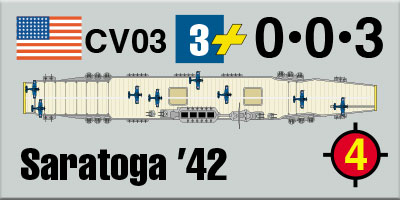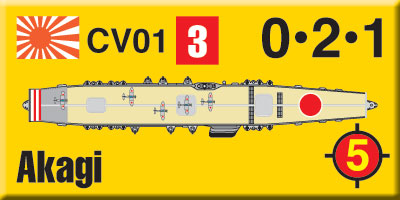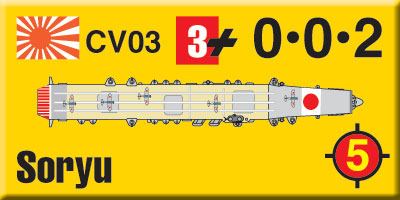| Golden Journal No. 53
Pacific Flattops
Publisher’s Preview
by Mike Bennighof, Ph.D.
March 2023
The Pacific War saw a shift in the perception and reality of naval power: it would no longer be determined by the battleship, but the aircraft carrier. The seven heavy carriers present at the Battle of Midway (four Japanese, three American) and the four that took part in the Battle of the Coral Sea (two for each side) decided the outcome. Their attending battleships, cruisers and destroyers contributed anti-aircraft fire and also fished down airmen out of the drink.
The Battles of the Eastern Solomons and Santa Cruz Islands told the same story: aircraft carriers ruled the seas, or at least the skies above them. At night, the battleships and cruisers might come out to play, but dawn saw them scurry away like mice rushing for their holes for fear of airplanes.

Given the importance of the heavy (or fleet) carrier, we decided to give them some special pieces reflecting their status. Golden Journal No. 53: Pacific Flattops is built around the huge pieces we use for legions in Rome at War and zeppelins in Great War at Sea: Zeppelins, giving the big aircraft carriers the respect that they deserve. The pieces are large, 0.625 inches wide by 1.3 inches long, which doesn’t look like much all written out, but it’s a huge increase. They do still fit (just barely) on the Second World War at Sea Tactical Map, but they’re big enough that you can put the pieces for the airplanes on Combat Air Patrol right there on the flight deck, which is pretty cool.
You don’t need these huge pieces to play the games. They play just fine with the standard-sized one that came with the game. But the games are much, much more fun with them. You can use the embiggened pieces in Second World War at Sea: Coral Sea, Second World War at Sea: Midway Deluxe Edition, and in Second World War at Sea: South Pacific; you can use them in other games, too, but the set is designed for those two (you probably won’t have a large piece for every aircraft carrier). The Journal includes pieces for all twelve fleet carriers that fought, or could have fought, at the Battles of Coral Sea and Midway, and in the two major carrier battles from the Solomons Campaign.
Just like the pieces from the games, these are die-cut and silky-smooth, frankly the best game pieces in the known universe. The print quality is amazing: the resolution is sop sharp that our old artwork simply isn’t good enough anymore. And they have rich color; these guys do not skimp on ink. The larger size, combined with that amazing print quality, lets us really show off the artwork of the ship deck drawings

The pieces are cut with ultra-sharp blades, so sharp that they can’t be touched by human hands. If they’re dropped, they’ll sink to the Earth’s core, so they have to be handled with great care. They press through the chipboard of the game pieces with minimal force, so there’s none of the mangling you’ll see from traditional die-cutting, no deep bathtub-like impression on the back side of the playing piece. We have to mark the back with a colored stripe, else you wouldn’t be able to tell the difference.
We’ve done this twice before, and the huge pieces have been very popular with hard-core players of our naval games. Golden Journal No. 31: Deluxe Bismarck has a set of all of the battleships and battle cruisers from Second World War at Sea: Bismarck, all on those huge pieces.
Golden Journal No. 46: Iron Dogs has a dozen battle cruisers for Great War at Sea: Dogger Bank (and the Dogger Bank scenarios from Great War at Sea: Jutland), all on the huge pieces. As they’re often the only capital ships in a Dogger Bank scenario, they look impressive on the Naval Tactical Map, with their accompanying light cruisers on the standard-sized pieces.

In Pacific Flattops, the Americans and Japanese get six big carriers apiece. For the Japanese, it’s the six ships that devastated the U.S. Pacific Fleet at Pearl Harbor: Akagi, Kaga, Hiryu, Soryu, Shokaku and Zuikaku. Shokaku and Zuikaku survived the Battle of the Coral Sea, but with enough damage (to the ship and the air group, respectively) to keep them sidelined for the Battle of Midway. The other four took part at Midway, where all four would be lost. The two survivors, Shokaku and Zuikaku, also fought at Eastern Solomons and Santa Cruz Islands.
Akagi and Kaga were already venerable ships by the time of their loss at Midway, having been converted during the 1920’s from a battle cruiser and a battleship respectively. Hiryu and Soryu were the first Japanese fleet carriers designed and laid down as such; Shokaku and Zuikaku were much larger and far more capable ships.
Fortuitously, the Americans also waged the first two years of the Pacific War with six heavy carriers: Lexington, Saratoga, Yorktown, Enterprise, Wasp, and Hornet. Enterprise, Lexington, and Saratoga avoided destruction at Pearl Harbor and participated in the abortive American pursuit after Pearl Harbor and the failed relief of Wake Island. Lexington and Yorktown fought at Coral Sea, where Lexington was lost. Enterprise, Hornet and Yorktown were at Midway, where Yorktown was lost. Saratoga and Wasp could have been there, but arrived too late; they did fight in the Solomons, where Wasp and Hornet were lost.

Lexington and Saratoga had begun their lives as huge, fast battle cruisers, converted to aircraft carriers before their completion. Yorktown, Enterprise, and Hornet were all sister ships, built to a very effective design that with modifications became the basis for the highly successful Essex class. Wasp, however, was a compromise design that satisfied no one, built to fit an extra carrier into treaty-allotted tonnage.
This being an Avalanche Press product, we’ll of course fill the book with technical details of the ships and the stories of their role in those key carrier battles. Only two ships from each side survived the first 11 months of the war: Shokaku and Zuikaku lasted until 1944, while Enterprise and Saratoga survived (Enterprise to be scrapped in 1958, Saratoga to be expanded as an atomic bomb test target).
The best part of the Golden Journal is that it’s free – that’s right, free – to the Gold Club, at least when we first offer it. After that, you have to pay for it.
The Golden Journal is only available to the Gold Club (that’s why we call it the Golden Journal).
Click here to join the Gold Club.
See your Gold Club Insider newsletter for ordering information.
Sign up for our newsletter right here. Your info will never be sold or transferred; we'll just use it to update you on new games and new offers.
Mike Bennighof is president of Avalanche Press and holds a doctorate in history from Emory University. A Fulbright Scholar and NASA Journalist in Space finalist, he has published a great many books, games and articles on historical subjects; people are saying that some of them are actually good.
He lives in Birmingham, Alabama with his wife, three children, and new puppy. He misses his lizard-hunting Iron Dog, Leopold.
Want to keep Daily Content free of third-party ads? You can send us some love (and cash) through this link right here.
|
